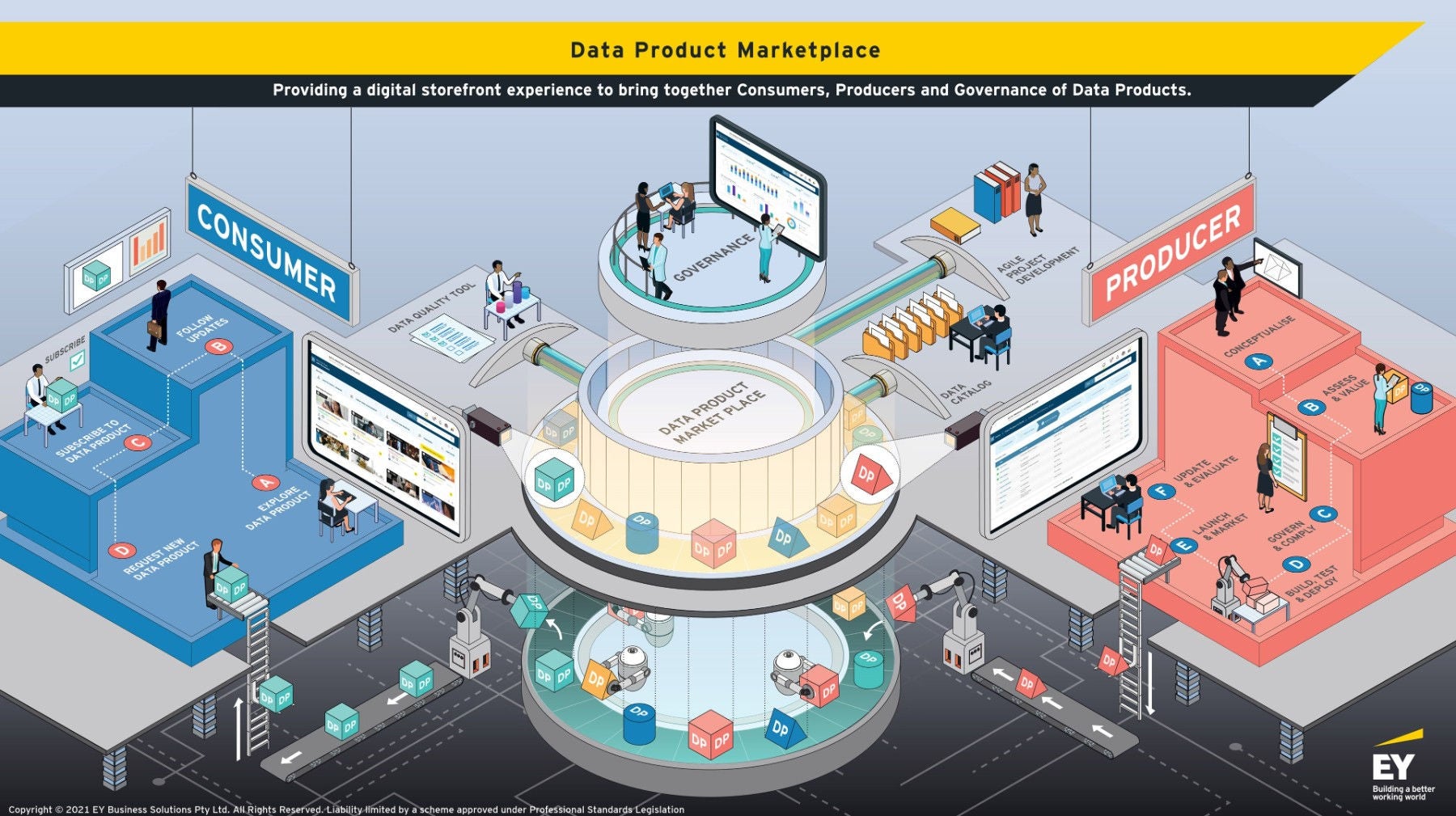EY refers to the global organization, and may refer to one or more, of the member firms of Ernst & Young Global Limited, each of which is a separate legal entity. Ernst & Young Global Limited, a UK company limited by guarantee, does not provide services to clients.

Invest in data analytics initiatives that easily access information and guide business decisions for maximum growth.
In brief
- Despite the investment of time and money, companies still struggle to provide business stakeholders the right data at the right time.
- Disconnects between what’s possible and the status quo have led innovators to abandon previous data strategies for an agile product management approach.
- Organizations that have adopted this new approach are exceeding the visions of early data strategies and achieving a level of data maturity rarely seen.
Chief data officers (CDOs) and chief information officers (CIOs) are focused on developing and implementing enterprise data strategies. Early efforts within the financial service sector focused on the defensive nature of data. The goal was to avoid billions of dollars in fines associated with inaccurate data and regulatory reporting. To satisfy regulatory inquiries, companies spent hundreds of millions of dollars on data strategies and the implementation of data capabilities such as data governance, data quality and centralized data hubs. With this significant investment, banks made incremental improvements in their data maturity, but struggled to demonstrate the business value gained from these efforts. This investment without measurable return pushed companies to pivot their strategies to use data to drive company growth. Data organizations began to work with business stakeholders to identify use cases where data could help drive revenue or reduce cost. While banks experienced pockets of success, these efforts were met with mixed results and rarely had a dramatic enterprise impact on a company’s data maturity or the broad adoption of the data capabilities. As the data technology landscape evolved, CIOs began to adopt a platform strategy and introduced concepts of a centralized data platform supported by new technologies such as data lakes, cloud, data mesh, machine learning and artificial intelligence with the intent to alleviate complex data problems and provide businesses with scalable and flexible capabilities. To this day, financial services companies continue to invest in data strategies and platforms hoping for improved data maturity that delivers business value.
As other sectors outside of financial services began to move through their own digital transformation and platform journeys, they realized the importance of having a well-formed data and analytics strategy. The early adopters in consumer product companies and health care considered the lessons learned from financial services. They realized previous attempts to achieve transformational change had three common problems that made success difficult to achieve:
- Data and analytics efforts were driven by information technology (IT)
- Business value was difficult to measure
- Adoption of data platforms and capabilities was limited
What is needed to disrupt previous approaches and transform into a data-driven organization? A product-driven culture where data and analytics squads are focused on addressing stakeholder needs, learning from feedback, and relentlessly prioritizing business value. By applying the concepts of agile product management to data in addition to the reports and analytics that consumes the data, EY clients are achieving measurable results, global adoption of enterprise data platform, and enterprise-wide product cultural alignment. An experienced analytics organization has worked with finance to agree on value measurement of individual analytic products across supply chain, planning and forecasting to achieve a combined $200M of annualized benefits across their portfolio of analytic products. These outcomes lead to growth, agility, and greater investment toward data and analytics.
There are three key aspects that help clients successfully transform into a mature data organization that connects data suppliers and consumers via hundreds of data and analytics products:
- Relentless focus on measuring value received from the data platform
- Establishing an organization structure and operating model that partners the enterprise data team with the analytics team
- Shifting the data and analytics culture to a product management mindset
Chapter 1
Measuring value from the data platform
CIOs are moving toward an ecosystem of composable platforms.
Composable platforms provide the building blocks for the company that help simplify the complexity of the current technology landscape and provide the agility to meet the needs of the business. Data products are created and maintained in the data platform. These data products are the building blocks that support a broad range of business capabilities.
Platforms that support specific business capabilities can typically be correlated to business value. For example, companies can measure the business value of a customer’s onboarding platform in the form of the number of customer conversions. Given the broad set of business capabilities the data platform supports, IT often struggles to quantify the value of the data platform. Companies that have successfully shifted to a data and analytics product approach have shifted the responsibility from IT measuring the value of the data platform to a shared responsibility between IT and the business measuring value of the products on the platform. These companies have baked value measurement into their agile product management approach. The enterprise data team and business stakeholders will have different approaches to value measurement, but all product owners require agreement on value measurement as part of program increment (PI) planning and embed value measurement throughout the agile framework.
Analytic product managers will work with business stakeholders and finance to measure financial value of the products. Business stakeholders that work with finance are more successful at accurately measuring value, providing credibility to the measurement and effectively communicate the value received. Organizations that adopt these approaches have better visibility of information technology investments and a direct correlation to the return on these investments. Ultimately this drives adoption of the data platform and increases investment in data and analytics.
Chapter 2
Partnering the enterprise data organization with the analytics organization
Connect data producers and analytics consumers.
Partnership between IT and the business is not limited to data platform value measurement. Clients continually ask what organization structure will help resolve the problems with previous approaches to data and analytics. They want to avoid duplication of data, siloed solutions, misaligned backlog, and disparate funding between enterprise data and analytics. Clients wrestle with multiple models. Most companies have a centralized data function within IT but struggle to clarify the role and scope of enterprise data. Determining who owns the integrated and aggregated data to support analytics adds more complexity to problem of duplicative data and inconsistent reporting. Companies will have either centralized or federated analytics functions; some companies will adopt a hybrid approach. A centralized analytics function could sit within IT or a unified function within the business. There are pros and cons to each model, and the models typically evolve as the company matures with respect to data and analytic products. No matter how a company organizes the enterprise data or the analytics functions, they must partner together in the creation of the data and analytic products. The two groups must align to a common operating model that serves the needs of the enterprise.
This partnership should include:
- Joint responsibility in the development of products
- A common backlog that is driven through regular planning and adjusting of priorities
- Integrated squads that include data roles and analytic roles
- Relentless approach to measuring business value
- Shared resource funding models
- Product alignment across business functions
As this symbiotic relationship evolves, both teams work as one to achieve the goals of the enterprise and drive company value. The enterprise data team provides foundational and consumable data products that adhere to enterprise standards, are widely adopted, enabled by enterprise technology capabilities, and consumed by analytics teams’ products. The analytics team works with business stakeholders to drive prioritization of the analytics and data products that deliver measurable business value with clear visibility into the return on each investment.
Chapter 3
Evolving the data and analytics culture
An agile culture can help address systemic data problems.
Organizational change and the alignment between the business and IT is not enough to address the data challenges of the past. Previous attempts at improving data maturity would typically include some aspect of change management to improve the data culture and become a data-driven organization. Companies established data councils and enterprise data governance to drive business involvement. IT and data organizations would align on the development of data policies, identification of business data owners, and establishment of a common data taxonomy to solve the systemic data problems of multiple sources of data, teams operating in silos, and inherently delivering inconsistent results. These previous efforts provided the sorely needed data capabilities for the enterprise, yet they rarely changed the culture or solved the systemic data problems.

Applying the concepts of product management to data and analytics can have a profound effect on the way IT and business stakeholders think and speak about data and analytics. Product owners or managers instil a sense of pride of ownership leading to the high-quality, governed data and analytics products that meet the standards of the enterprise data platform. The agile squads and product managers are focused on outcomes or results versus the individual activities. Product managers will want to drive broad adoption of their products, inherently minimizing the multiple sources of truth. Squads and product managers evolve into looking at every product and backlog item with a strategic cross functional lens versus a single function focus.
Summary
This shift to agile product development occurs when business stakeholders are well-versed in the data and analytic products and the backlog items that will drive their business. Business and IT stakeholders participate in annual and quarterly planning that determines prioritization and funding where every product is measured by impact to the business or adoption by the enterprise. Functional executives have visibility into how their data and analytics funds are being used and the return they are achieving from their investments. These cultural shifts drive an increased demand and funding for data and analytics.
How EY can help
-
EY's analytics consulting services utilizes the latest technology to integrate data and analytics throughout your business process and operation.
Read more



